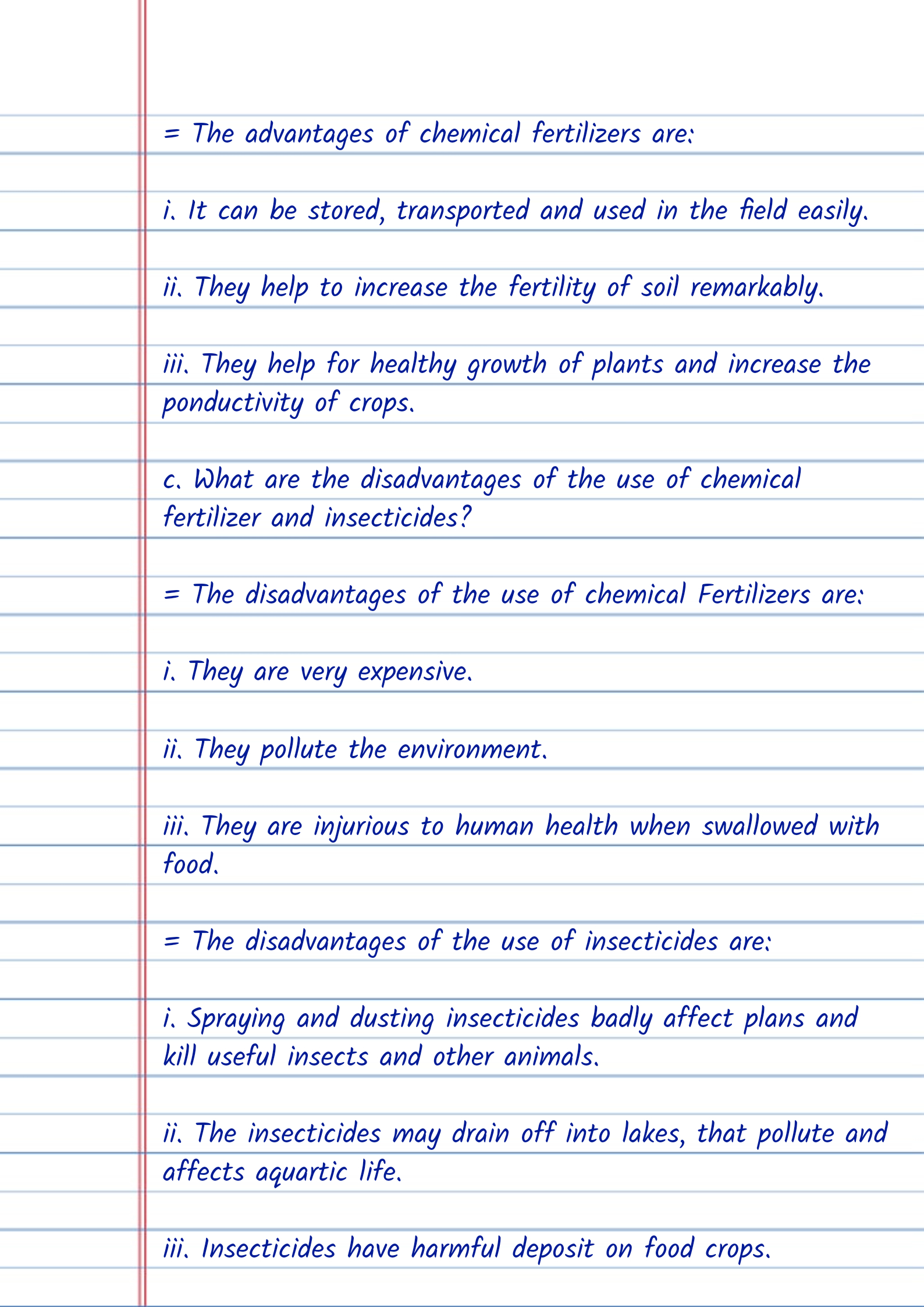 |
Materials Used In Daily Life |
1. Short answer type questions.
a. What are micronutrients?
= Those chemical elements which are required by plants in smaller quantities (100 mg/litre or less than 100 mg/litre of water) are known as micronutrients or secondary nutrients.
b. Write the names of macronutrients.
= The names of macronutrients are Carbon (C), Hydrogen(H), Oxygen (O), sulphur (s), etc.
c. What is compost manure?
= The black mass of substances formed by the partial decompostion of cattle dung, organic residues and debris in pit is called compost manure.
d. Name any three plants which are used as green manures.
= Barseem, Dhaincha, soyabean are three plants which are used as green manures.
e. Write any one disadvantage of the use of chemical fertilizers.
= The one disadvantage of the use of chemical fertilizer are:
i. Chemical fertilizers are very expensive.
f. What are insecticides?
= The poisonous chemical substances which are used to repel, kill or destroy hamful insects are called insecticides.
g. What are NPK fertilizers?
= NPK fertilizers are chemical fertilizers made up of Nitrogen(N), Phosphorus(P), and Potassium(K). These three elements are essential for healthy plant growth and development, and NPK fertilizers provide place with the nutrients they need in the correct ratio.
h. Name any carbamate insecticides.
= Baygon, Zectran, Dimetan, etc.
i. What is the full form of DDT and BHC?
= DDT - Dichlorodiphenly trichloroethane
BHC - Benzene heachloride
j. What is fertilizer?
= Any substance containing chemical nutrients or elements which enhances the fertility of soil leading to the healthy growth of plant is called fertilizers.
2. Long answer type questions:
a. Introduce macronutrients and micronutrients with examples.
= Those chemical elements which are required by living plants in greater quantities (more than 100 mg/litre of water) are known as macro-nutrients or primary nutrients ex: Carbon (C), Hydroen (H), Oxygen (0), Nitrogen (N),etc.
= Those chemical elements which are required by plants is smaller (100 mg/litre or less than loomg/ litre of water) are known as micronutrients or secondary nutrients ex: Boron (B), iran, (Fe), zinc (Zn), etc.
b. What are chemical fertilizers? Explain their types and advantages.
= The fertilizers which are manufactured in the factories using various chemical substances are called chemical fertilizer. Their types are:
i. Single fertilizers: The fertilizers which contains only one primary nutrient.
ii. Mixed fertilizers: The fertilizers which contain more than one primary plant nutrients.
iii. Complete fertilizers: The fertilizers which contain all the three primary nutrients viz.
= The advantages of chemical fertilizers are:
i. It can be stored, transported and used in the field easily.
ii. They help to increase the fertility of soil remarkably.
iii. They help for healthy growth of plants and increase the ponductivity of crops.
c. What are the disadvantages of the use of chemical fertilizer and insecticides?
= The disadvantages of the use of chemical Fertilizers are:
i. They are very expensive.
ii. They pollute the environment.
iii. They are injurious to human health when swallowed with food.
= The disadvantages of the use of insecticides are:
i. Spraying and dusting insecticides badly affect plans and kill useful insects and other animals.
ii. The insecticides may drain off into lakes, that pollute and affects aquartic life.
iii. Insecticides have harmful deposit on food crops.
d. Write the effects of the lack of potassium and phosphorus in plants.
= The symptoms of the deficiency of potassium and phosphorus in plants are:
i. disease in the immunity power of plants against disease.
ii. wilting and wethering of leaves.
iii. the reduction of the disease resistant power of plants.
iv. firing and yellowing along the leaf margins.
v. thin and weak plants and prolonged maturity of crops.
vi. Decrease of the rate of cell division.
vii. indequate growth and development of roots.
viii. appearance of red purple colour along the leaf margins.
e. How is Jholmol made? Write the benefits of its application in crops?
= Jholmol is prepared by mixing animal urine, dung and water at 1:1:1 ratio and fermented for two weeks. The benefits of its application in are:
i.. Easy to use.
ii. Residue
iii. Resistance
iv. production of organic vegetables and health.
f. How is compost manure made?
= Compost manure prepared by partial decomposition of mixture of cattle dung, farm wastes, crop residues and other organic debris in a pit with alternating layers of soil. The complex mass in pit is decompared by bacteria and fungi for 2-3 months to form compost manure.
g. Write any two reasons to justify that compact fertilizer is better than chemical fertilizer.
= The two reasons to justify that compost fertilizer is better than chemical fertilizer are:
i. Compost fertilizer control soil erosion, leaching and environmental pollution whereas chemical fertilizer pollute the environment.
ii. Compost fertilizer easily available chemical fertilizer are the cheapest and sources of fertilizers whereas are very expensive.
h. Write the advantages of chemical fertilizers.
= The advantages of chemical fertilizers are:
i. They help to increase the fertility of soil remarkably.
ii. They help for healthy growth of plants and increase the productivity of crops.
iii. They contain main mineral nutrients like nitrogen, phosphorus and potassium necessary for plants.
iv. They can be stored, transported and used in the field easily.
i. What are bio-insecticides? Write with examples.
=Bio-insecticides are naturally occuring solutions compounds that suppress the growth and spread of insects population by diverse actions. ex. Malabar nut (asuro), titepati, neem, Vinegar, etc.









0 Comments